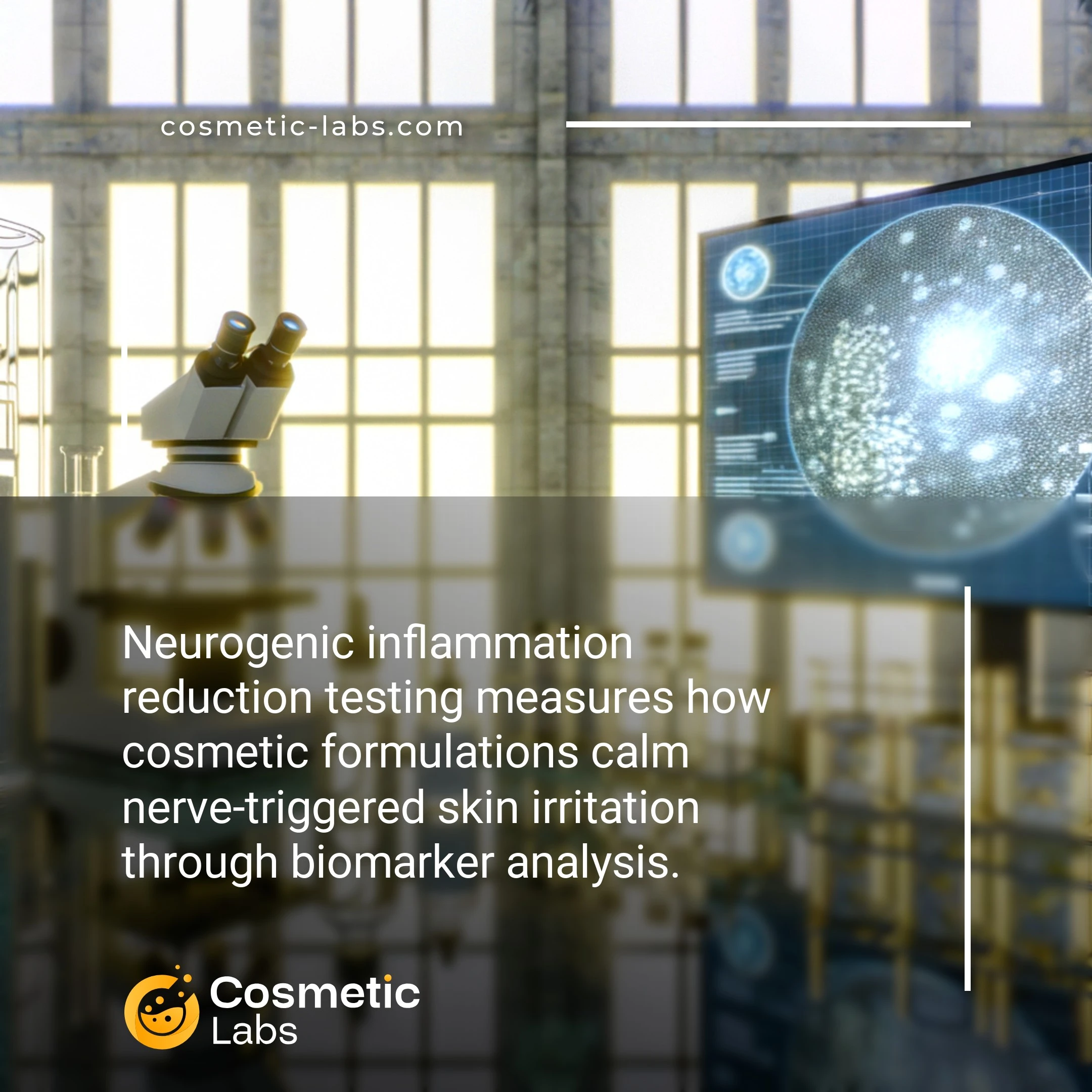Neurogenic Inflammation Testing for Sensitive Skin Products

What is Neurogenic inflammation reduction?
Neurogenic inflammation reduction testing measures how cosmetic formulations calm nerve-triggered skin irritation through specialized assays that monitor neuropeptide release and sensory nerve activation. Labs use in vitro models with cultured sensory neurons to evaluate ingredient efficacy in blocking substance P and CGRP pathways—key mediators that cause redness, stinging, and discomfort in sensitive skin conditions like rosacea and atopic dermatitis.
Why do you need this service?
Cosmetic labs use neurogenic inflammation reduction testing to validate anti-irritation claims for sensitive skin formulations, particularly when developing products with active ingredients like retinoids, AHAs, or peptides. This testing helps brands demonstrate reduced sensory discomfort and skin reactivity through objective measurements of nerve-mediated inflammatory responses, providing the clinical evidence needed for marketing claims and regulatory submissions.
Who provides Neurogenic inflammation reduction services?
All cosmetic labs providing Neurogenic inflammation reduction services
There is no company providing these services at the moment.
Neurogenic Inflammation Testing for Sensitive Skin Products
Neurogenic inflammation testing measures how cosmetic formulations affect nerve-mediated skin responses that trigger irritation and discomfort. These specialized assays help you validate products designed for sensitive skin by quantifying inflammatory mediators released through neuronal pathways.
Biomarker Analysis and Measurement Protocols
Labs use substance P and CGRP (calcitonin gene-related peptide) measurements to track neurogenic responses in skin models. These neuropeptides directly correlate with the burning, stinging, and itching sensations your customers experience with poorly formulated products.
Testing protocols include:
- Capsaicin challenge tests on reconstructed skin models
- Neuropeptide release quantification via ELISA
- Inflammatory cascade mapping through cytokine panels
- Sensory neuron activation studies using calcium imaging
Application in Product Development
This testing proves particularly valuable for anti-aging serums, acne treatments, and daily-use products where skin tolerance determines market success. You’ll receive data showing how your formulation affects nerve fiber activation compared to untreated controls.
Results help you optimize ingredient concentrations, select gentler preservatives, and validate marketing claims about reduced irritation. Many brands use this data to support “dermatologist-tested” or “suitable for sensitive skin” positioning.
Ready to validate your sensitive skin formulations? Connect with specialized labs on our platform that offer neurogenic inflammation testing services tailored to your product development needs.
Practical Applications of Neurogenic Inflammation Testing for Sensitive Skin Products
Brands use neurogenic inflammation reduction testing to validate calming claims and optimize formulations for reactive skin conditions before market launch.
Pre-Market Validation for Anti-Inflammatory Claims
Labs measure substance P release and CGRP levels to quantify how formulations reduce neurogenic inflammation pathways. This testing validates marketing claims about soothing irritated skin and reducing redness. Brands typically see 15-30% reductions in inflammatory markers within 24-48 hours of application.
The data supports regulatory submissions and provides scientific backing for sensitive skin claims. Testing protocols include patch testing with inflammatory triggers followed by topical application of test products.
Ingredient Screening for Sensitive Skin Formulations
Cosmetic labs screen individual ingredients and complete formulations using neurogenic inflammation assays before full product development. This approach identifies potential irritants early and optimizes active concentrations. Teams test ingredient combinations at various pH levels to determine optimal formulation parameters.
The screening process typically takes 2-3 weeks and helps brands avoid costly reformulations later. Labs use human skin models and ex-vivo testing to predict real-world performance accurately.
| Testing Method | Timeline | Key Markers Measured | Typical Applications |
|---|---|---|---|
| Substance P Release Assay | 24-48 hours | Neuropeptide levels | Anti-aging serums, calming creams |
| CGRP Quantification | 2-4 hours | Vasodilation markers | Rosacea treatments, barrier repair |
| Neurogenic Inflammation Panel | 3-5 days | Multiple inflammatory pathways | Sensitive skin product lines |
Ready to validate your sensitive skin formulations? Contact specialized cosmetic labs on our platform to discuss neurogenic inflammation testing protocols tailored to your product development needs.
